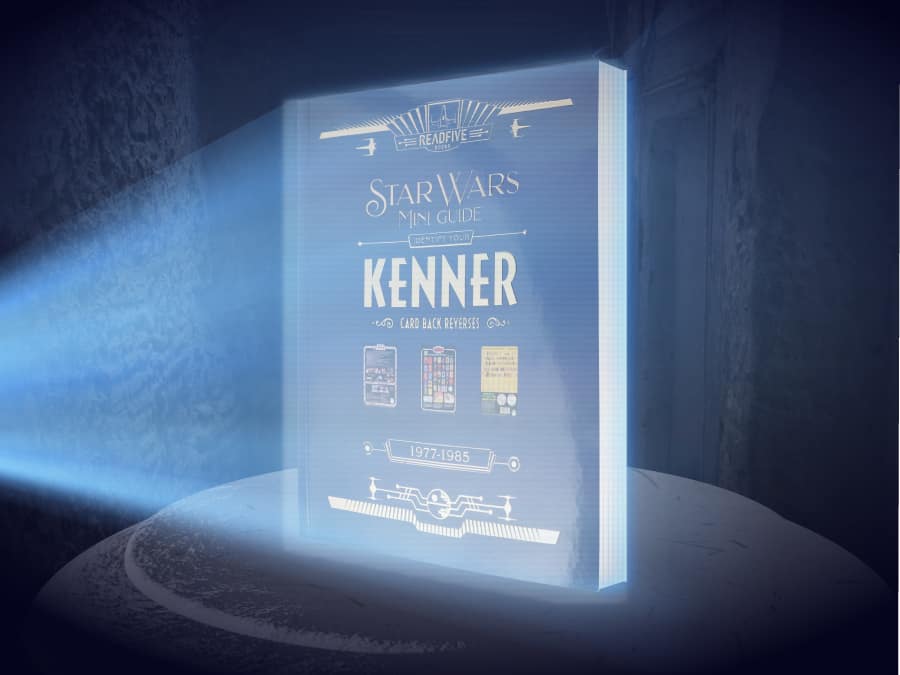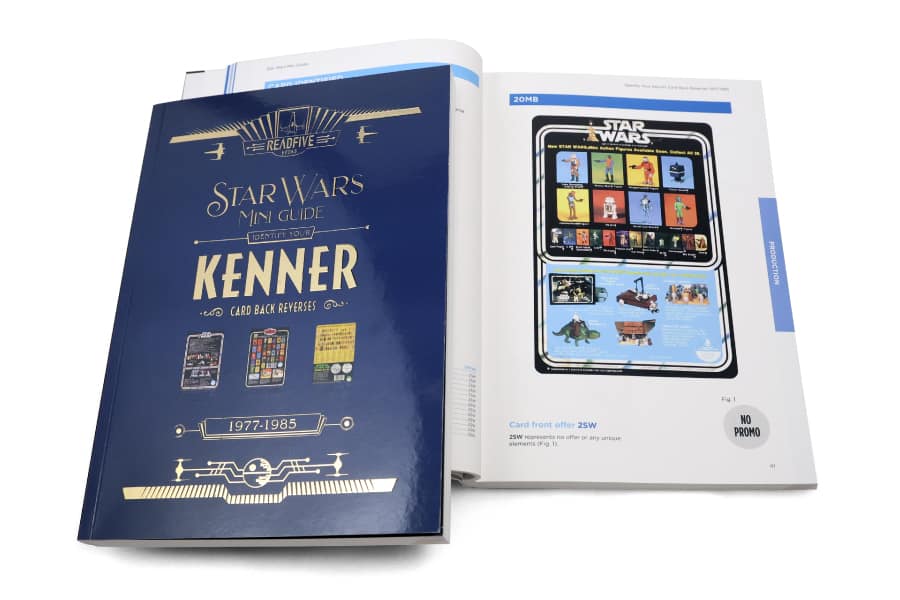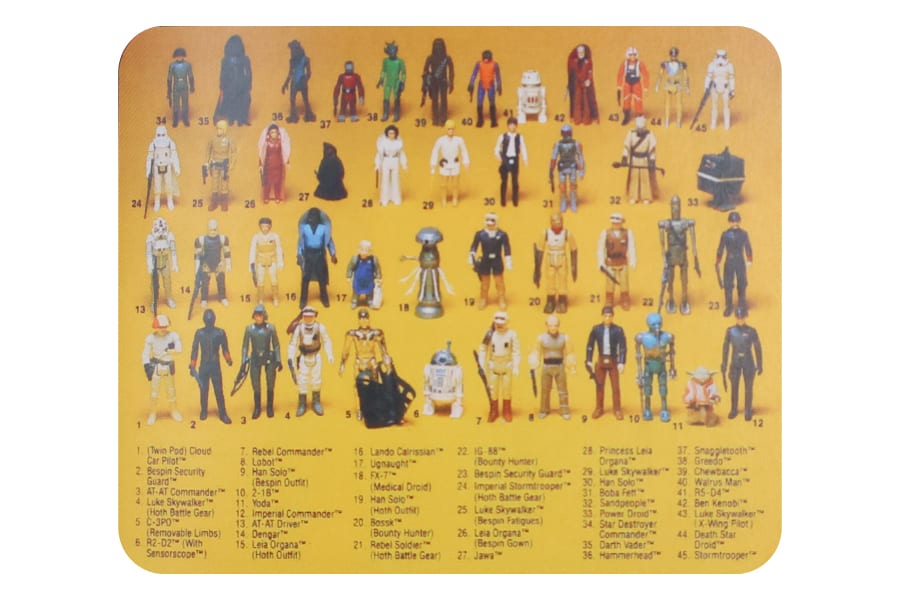Star Wars gününü kutlamak ve yeni Ciltsiz Kitap Baskısı servisinde, "Star Wars Mini Rehberi "nin ortak yazarı Gianni Venturini ile konuştuk: Kenner Kartınızın Arka Yüzünü Tanımlayın" kitabının yazarlarından Gianni Ventini ile konuştuk. Star Wars figürleri koleksiyoncuları için bu vazgeçilmez referans, geçen yıl Solopress.com'dan sipariş edilebilecek yeni bir ürün olarak Paperback Books'u piyasaya sürmemizin bir parçası olarak Solopress tarafından basıldı. Gianni ile Star Wars konusundaki tutkusunu ve bilgisini nasıl kazandığını ve yeni kitabın nasıl ortaya çıktığını konuştuk.
Uzun zaman önce Shepherd's Bush'ta....
İlk olarak Gianni'ye Star Wars evreniyle ilk karşılaşmasını sorduk. Onun hikayesi de kendi kuşağındaki pek çok kişininkine benziyor:
Annem beni ve kardeşimi Shephard's Bush'a filmi izlemeye götürmüştü. Sanırım yarıyıl tatilindeydi, Şubat 1978 civarındaydı, yani o zamanlar sadece dört yaşındaydım. Bence bu filme gerçekten ilgi duyan ve benzer yaşlarda olan pek çok insan var, çünkü çok büyük bir etki yarattı.
Bu biçimlendirici deneyim, film karakterlerini tasvir eden oyuncak figürlere olan çocukluk aşkını ortaya çıkardı. Yeni figürler edinmek genç Gianni için bir hayranlık haline geldi:
Ondan sonraki Noel'lerim hep bu Star Wars Aksiyon figürlerini almakla geçti, tek istediğim buydu.
Kurs Yeniden Uyanıyor
Pek çok genç gibi Gianni de ergenlik çağına geldiğinde çocukluğundaki oyuncaklara olan ilgisi azalmaya başladı. Ancak Gianni'nin Star Wars figürlerine olan tutkusu, London College of Printing'de (şimdiki adıyla London College of Communication) bir kursa katıldığında yeniden uyandı:
Tabii ki bu tür şeyleri aşıyorsunuz ama daha sonra Elephant and Castle'daki London College of Printing'e (şimdiki adıyla London College of Communication) gittim. Oradayken, bir arkadaşım bir kitap getirdi. Steve Sansweet Star Wars hatıralarından oluşan en büyük özel koleksiyona sahip tanınmış bir koleksiyoncu.
Kitabı inceleyen Gianni, oyuncak şirketi Kenner'ın ürettiği son on yedi figürün yer aldığı son figür sayısıyla ilgili bir bölüm gördü. Bunlar daha önce hiç görmediği figürlerdi. Bu noktada Gianni, ürün yelpazesinin tamamından bir şekilde habersiz olduğunu fark etti. Bu, figürlere olan tutkusunu yeniden alevlendirdi ve onu daha fazlasını öğrenmek için bir rotaya soktu:
Beni koleksiyonculuğa geri döndüren şey buydu. Dışarı çıkıyor ve çocukken karşılaşmadığım bu figürleri temin ediyordum. O zamanlar bu pek de kolay bir şey değildi. Ebay o zamanlar pek önemli bir şey değildi. Her şey oyuncak fuarlarına ve bunun gibi şeylere gidip elinize ne geçerse almakla ilgiliydi.
Koleksiyoncunun Yükselişi
Bu noktada, bir öğrenci olarak Gianni, bozulmamış kutulu örneklerin koleksiyoncusu olmanın gerektirdiği masrafı karşılayamayacağını düşündü, bu yüzden çocukken karşılaşmadığı karakterlerin serbest figürlerini aramaya başladı. Yine de bu örnekler uzun vadede iyi bir yatırım olduğunu kanıtladı:
O zamanlar gevşek figürler bana hala pahalı geliyordu, ancak zaman içinde onların bile değeri önemli ölçüde arttı. Bugünkü fiyatlarla kıyaslandığında çok ucuzlardı, bu yüzden onları toplamak için iyi bir zamandı.
Sadece Avrupa ve Kanada'da bulunan Yak Face adında tanınmış bir figürü aldığımı hatırlıyorum, ABD'de bulamıyordunuz. O zamanlar tam bir servet gibi görünen 50 sterlindi ama bugün değeri 400 sterlin civarında!
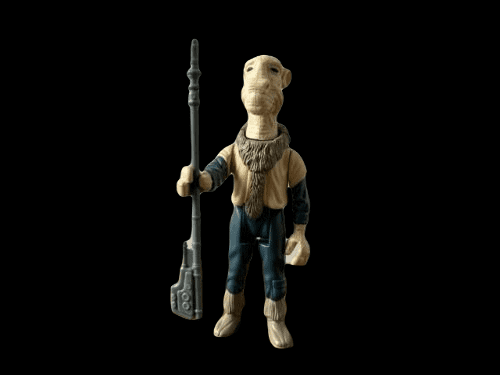
Read Five Designs doğdu
Sonraki yıllarda Gianni'nin figürlerin üretim süreçlerinin tüm yönlerine duyduğu hayranlık ve koleksiyonu da büyüdü. Bu durum sonunda Gianni'nin Beş Tasarımı Okuyun meraklısı Gregory Armstrong ile birlikte.
Şirket, hem Star Wars evrenini kutlayan hem de bazı durumlarda figür koleksiyoncuları için bir kontrol listesi görevi gören muhteşem orijinal tasarımlara sahip posterler yayınladı. Kitaplara geçiş, Kenner tarafından üretilen Star Wars figürlerini belgeleyen kapsamlı, A3 kahve masası kitabıyla geldi.
Tüm rakamlar eşit yaratılmamıştır...
Gianni'ye Kenner'ın figürlerin üretimindeki rolünü sorduk:
Kenner oyuncakların haklarına sahip olan şirketti, ancak üretimi farklı şirketlere yaptırıyorlardı. Unitoy, Smile ve Kader olmak üzere üç üretici vardı ve üretim ağırlıklı olarak Hong Kong, Tayvan ve Makao'da gerçekleştiriliyordu.
Dünyanın farklı bölgelerindeki lisans sahipleri ve üreticiler arasındaki karmaşık düzenlemeler koleksiyoncular için bir başka cazibe kaynağı olacaktı. Gianni'ye göre:
Bu da figürler arasında farklılıklara yol açarak koleksiyoncuların başka bir tavşan deliğine girmesine neden oldu. Bir versiyonu alırlar ve sonra bir başkasını alırlar çünkü kalıplama biraz farklıdır veya farklı bir malzemeden yapılmıştır!
İyi bir patlatıcıyla boy ölçüşemez
Koleksiyoncular için bir başka ilgi alanı da figürlere eşlik eden aksesuarlardır. Bir karakterin blasterinin, ışın kılıcının, kaskının ya da diğer kişisel eşyalarının hâlâ yanında olup olmaması o karakterin değeri üzerinde büyük bir etkiye sahip olabilir. Gianni'nin yorumladığı gibi:
Aksesuarların çoğu küçük plastik parçalarıydı, zaman içinde nasıl kaybolduğunu hayal etmek kolay. R2-D2'nun günümüzde nadir bulunan bir ışın kılıcı aksesuarı ile birlikte gelen özel bir versiyonu vardı. Işın kılıcı, Return of the Jedi filminde Jabba'nın yelkenli mavnasındaki sahnede olduğu gibi R2-D2 figüründen dışarı fırlıyordu. Tahmin edebileceğiniz gibi, bir çocuk için kaybetmesi çok kolay bir şey!
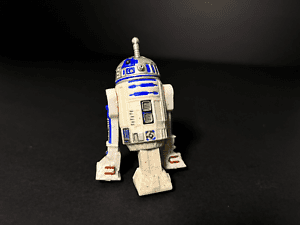
Beni bedenime göre yargılıyorsun, değil mi?
Bu yüzden Read Five finansman sağlamaya ve "Star Wars Oyuncak Rehberi Birinci Cilt, Kenner Aksiyon Figürleri 1977-1985". Ağır bir kitap olduğu ortaya çıktı, ancak aynı zamanda belirli temel bilgilere odaklanan daha hafif, ciltsiz mini kılavuzlar üretme fikrini de doğurdu.
Kenner figürlerinin tarihini ve şimdiye kadar çıkan tüm varyasyonlarını anlatan, 500 sayfadan fazla A3 boyutunda, kahve masası tarzında bir kitap hazırladık. Bunu üretirken cep tipi rehberler üretebileceğimizi fark ettik, ana kitaptan belirli bilgileri çekerek insanların yanlarında taşıyabilecekleri bu cep rehberlerini üretebilirdik.
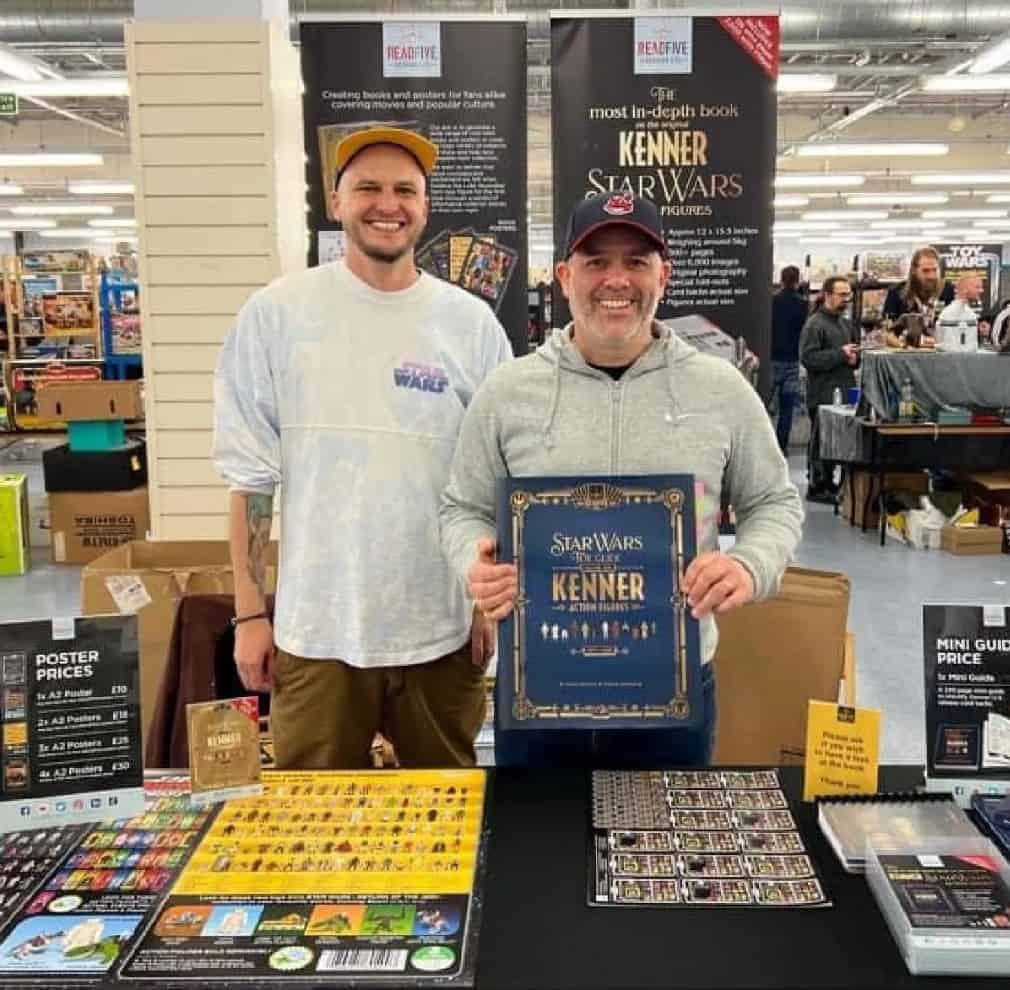
Gianni, ilk mini kılavuz için kart arkalarına, yani aksiyon figürünü ve aksesuarlarını içeren baloncuğun takılı olduğu kart parçasına odaklanmaya karar verdi:
Bilinmeyen bir kartı geri alabileceğiniz ve sorular sorarak ve kitapta gezinerek olumlu bir tanımlamaya ulaşabileceğiniz bu cep kitabı fikrimiz vardı. Biraz şu "Kendi maceranı kendin seç" kitaplarına benziyor.
Olasılıklar ne olursa olsun başarılı navigasyon
Bu, "Star Wars Mini Kılavuzu "nun ana vuruşudur: Kenner Kartınızın Arka Yüzünü Tanımlayın". Rehber size tanımlanamayan kartınız hakkında bir dizi soru soruyor: Hangi logoya sahip? Kartın üzerinde kaç tane resimli karakter var? Üzerinde bir çıkartma var mı?
Her cevap için, belirli bir sayfaya atlamak ve bir sonraki soruyu cevaplamak için bir talimat vardır. Seçenekleri azalttıktan ve diğer tüm olasılıkları eledikten sonra KART TANIMLANDI sayfasına ulaşırsınız. Koleksiyoncular için eşsiz derecede değerli bir kaynaktır.
Malzeme ve yüzey seçimi
Sıra ciltsiz mini rehber için kağıt stokları ve yüzeyleri seçmeye geldiğinde, Gianni'nin baskı ve tasarım konusundaki deneyimi ön plana çıktı.
Rehber, 500 sayfalık A3 sehpa kitabının yavrusuydu, bu nedenle belirli bir aile benzerliği olması gerekiyordu. Gianni, büyük boy orijinalinin premium hissini yansıtmak için altın varak harflerle parlak lamine bir karton tercih etti. Parlak lamine, 300gsm kapak dayanıklılığa yardımcı olurken, altın varak yazı başlığa güç ve otorite kazandırdı.
İç sayfalar için kağıt stoğu seçimi söz konusu olduğunda, renkle ilgili hususlar çok önemliydi. Kart sırtlarındaki renklerin doğru bir şekilde yeniden üretilmesi ihtiyacına ek olarak, kitabın benzersiz navigasyon sistemi, okuyucuların bölümler arasında hızlı ve kolay bir şekilde hareket edebilmesi için bir renk koduna dayanıyordu.
Rengin önemi
Renk, kart arkalarını kategorize etmenin birincil yolu olarak kullanıldı; mavi Star Wars'u, kırmızı Empire Strikes Back'i, yeşil Return of the Jedi'ı ve turuncu Power of the Force serisini temsil ediyor.
Bu renklerin farklı tonları kart sırtlarındaki varyasyonları da temsil ettiğinden, rehberin amaçlandığı gibi çalışması için doğru renk üretimi şarttı. Gianni, güzel bir şekilde sunulan sanat eserlerinin canlı ve doğru bir şekilde çoğaltılmasını sağlamak için 120 gsm beyaz ipek iç sayfaları seçti.
Yıldızlara ulaşmak ve kendi kitabınızı yayınlamak için ilham alıyorsanız, bu ister Gianni'ninki gibi bir referans rehberi isterse bir ilk roman olsun, bizim Ciltsiz Kitaplar baskı hizmeti profesyonel sonuçlar sağlayacaktır.

